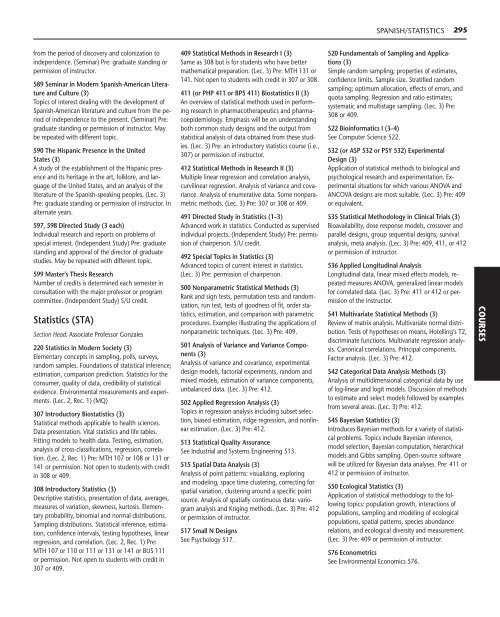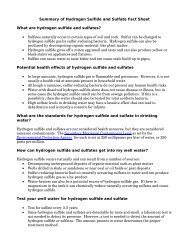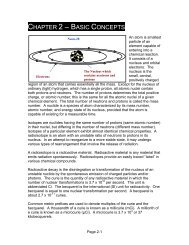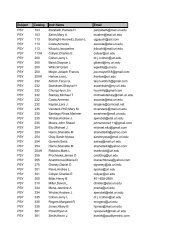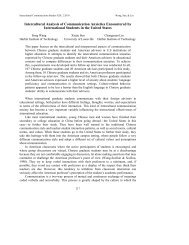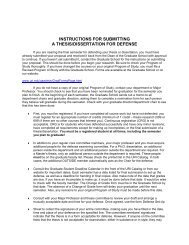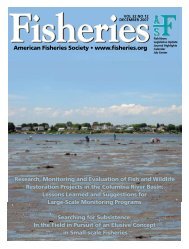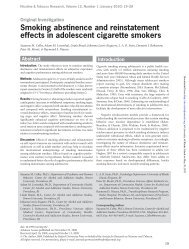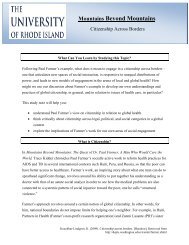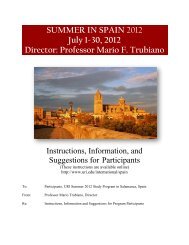UNDERGRADUATE PROGRAMS The - University of Rhode Island
UNDERGRADUATE PROGRAMS The - University of Rhode Island
UNDERGRADUATE PROGRAMS The - University of Rhode Island
Create successful ePaper yourself
Turn your PDF publications into a flip-book with our unique Google optimized e-Paper software.
from the period <strong>of</strong> discovery and colonization to<br />
independence. (Seminar) Pre: graduate standing or<br />
permission <strong>of</strong> instructor.<br />
589 Seminar in Modern Spanish-American Literature<br />
and Culture (3)<br />
Topics <strong>of</strong> interest dealing with the development <strong>of</strong><br />
Spanish-American literature and culture from the period<br />
<strong>of</strong> independence to the present. (Seminar) Pre:<br />
graduate standing or permission <strong>of</strong> instructor. May<br />
be repeated with different topic.<br />
590 <strong>The</strong> Hispanic Presence in the United<br />
States (3)<br />
A study <strong>of</strong> the establishment <strong>of</strong> the Hispanic presence<br />
and its heritage in the art, folklore, and language<br />
<strong>of</strong> the United States, and an analysis <strong>of</strong> the<br />
literature <strong>of</strong> the Spanish-speaking peoples. (Lec. 3)<br />
Pre: graduate standing or permission <strong>of</strong> instructor. In<br />
alternate years.<br />
597, 598 Directed Study (3 each)<br />
Individual research and reports on problems <strong>of</strong><br />
special interest. (Independent Study) Pre: graduate<br />
standing and approval <strong>of</strong> the director <strong>of</strong> graduate<br />
studies. May be repeated with different topic.<br />
599 Master’s <strong>The</strong>sis Research<br />
Number <strong>of</strong> credits is determined each semester in<br />
consultation with the major pr<strong>of</strong>essor or program<br />
committee. (Independent Study) S/U credit.<br />
Statistics (STA)<br />
Section Head: Associate Pr<strong>of</strong>essor Gonzales<br />
220 Statistics in Modern Society (3)<br />
Elementary concepts in sampling, polls, surveys,<br />
random samples. Foundations <strong>of</strong> statistical inference;<br />
estimation, comparison prediction. Statistics for the<br />
consumer, quality <strong>of</strong> data, credibility <strong>of</strong> statistical<br />
evidence. Environmental measurements and experiments.<br />
(Lec. 2, Rec. 1) (MQ)<br />
307 Introductory Biostatistics (3)<br />
Statistical methods applicable to health sciences.<br />
Data presentation. Vital statistics and life tables.<br />
Fitting models to health data. Testing, estimation,<br />
analysis <strong>of</strong> cross-classifications, regression, correlation.<br />
(Lec. 2, Rec. 1) Pre: MTH 107 or 108 or 131 or<br />
141 or permission. Not open to students with credit<br />
in 308 or 409.<br />
308 Introductory Statistics (3)<br />
Descriptive statistics, presentation <strong>of</strong> data, averages,<br />
measures <strong>of</strong> variation, skewness, kurtosis. Elementary<br />
probability, binomial and normal distributions.<br />
Sampling distributions. Statistical inference, estimation,<br />
confidence intervals, testing hypotheses, linear<br />
regression, and correlation. (Lec. 2, Rec. 1) Pre:<br />
MTH 107 or 110 or 111 or 131 or 141 or BUS 111<br />
or permission. Not open to students with credit in<br />
307 or 409.<br />
409 Statistical Methods in Research I (3)<br />
Same as 308 but is for students who have better<br />
mathematical preparation. (Lec. 3) Pre: MTH 131 or<br />
141. Not open to students with credit in 307 or 308.<br />
411 (or PHP 411 or BPS 411) Biostatistics II (3)<br />
An overview <strong>of</strong> statistical methods used in performing<br />
research in pharmacotherapeutics and pharmacoepidemiology.<br />
Emphasis will be on understanding<br />
both common study designs and the output from<br />
statistical analysis <strong>of</strong> data obtained from these studies.<br />
(Lec. 3) Pre: an introductory statistics course (i.e.,<br />
307) or permission <strong>of</strong> instructor.<br />
412 Statistical Methods in Research II (3)<br />
Multiple linear regression and correlation analysis,<br />
curvilinear regression. Analysis <strong>of</strong> variance and covariance.<br />
Analysis <strong>of</strong> enumerative data. Some nonparametric<br />
methods. (Lec. 3) Pre: 307 or 308 or 409.<br />
491 Directed Study in Statistics (1–3)<br />
Advanced work in statistics. Conducted as supervised<br />
individual projects. (Independent Study) Pre: permission<br />
<strong>of</strong> chairperson. S/U credit.<br />
492 Special Topics in Statistics (3)<br />
Advanced topics <strong>of</strong> current interest in statistics.<br />
(Lec. 3) Pre: permission <strong>of</strong> chairperson.<br />
500 Nonparametric Statistical Methods (3)<br />
Rank and sign tests, permutation tests and randomization,<br />
run test, tests <strong>of</strong> goodness <strong>of</strong> fit, order statistics,<br />
estimation, and comparison with parametric<br />
procedures. Examples illustrating the applications <strong>of</strong><br />
nonparametric techniques. (Lec. 3) Pre: 409.<br />
501 Analysis <strong>of</strong> Variance and Variance Components<br />
(3)<br />
Analysis <strong>of</strong> variance and covariance, experimental<br />
design models, factorial experiments, random and<br />
mixed models, estimation <strong>of</strong> variance components,<br />
unbalanced data. (Lec. 3) Pre: 412.<br />
502 Applied Regression Analysis (3)<br />
Topics in regression analysis including subset selection,<br />
biased estimation, ridge regression, and nonlinear<br />
estimation. (Lec. 3) Pre: 412.<br />
513 Statistical Quality Assurance<br />
See Industrial and Systems Engineering 513.<br />
515 Spatial Data Analysis (3)<br />
Analysis <strong>of</strong> point patterns: visualizing, exploring<br />
and modeling, space time clustering, correcting for<br />
spatial variation, clustering around a specific point<br />
source. Analysis <strong>of</strong> spatially continuous data: variogram<br />
analysis and Kriging methods. (Lec. 3) Pre: 412<br />
or permission <strong>of</strong> instructor.<br />
517 Small N Designs<br />
See Psychology 517.<br />
SPANISH/STATISTICS<br />
295<br />
520 Fundamentals <strong>of</strong> Sampling and Applications<br />
(3)<br />
Simple random sampling; properties <strong>of</strong> estimates,<br />
confidence limits. Sample size. Stratified random<br />
sampling; optimum allocation, effects <strong>of</strong> errors, and<br />
quota sampling. Regression and ratio estimates;<br />
systematic and multistage sampling. (Lec. 3) Pre:<br />
308 or 409.<br />
522 Bioinformatics I (3–4)<br />
See Computer Science 522.<br />
532 (or ASP 532 or PSY 532) Experimental<br />
Design (3)<br />
Application <strong>of</strong> statistical methods to biological and<br />
psychological research and experimentation. Experimental<br />
situations for which various ANOVA and<br />
ANCOVA designs are most suitable. (Lec. 3) Pre: 409<br />
or equivalent.<br />
535 Statistical Methodology in Clinical Trials (3)<br />
Bioavailability, dose response models, crossover and<br />
parallel designs, group sequential designs, survival<br />
analysis, meta analysis. (Lec. 3) Pre: 409, 411, or 412<br />
or permission <strong>of</strong> instructor.<br />
536 Applied Longitudinal Analysis<br />
Longitudinal data, linear mixed effects models, repeated<br />
measures ANOVA, generalized linear models<br />
for correlated data. (Lec. 3) Pre: 411 or 412 or permission<br />
<strong>of</strong> the instructor.<br />
541 Multivariate Statistical Methods (3)<br />
Review <strong>of</strong> matrix analysis. Multivariate normal distribution.<br />
Tests <strong>of</strong> hypotheses on means, Hotelling’s T2,<br />
discriminate functions. Multivariate regression analysis.<br />
Canonical correlations. Principal components.<br />
Factor analysis. (Lec. 3) Pre: 412.<br />
542 Categorical Data Analysis Methods (3)<br />
Analysis <strong>of</strong> multidimensional categorical data by use<br />
<strong>of</strong> log-linear and logit models. Discussion <strong>of</strong> methods<br />
to estimate and select models followed by examples<br />
from several areas. (Lec. 3) Pre: 412.<br />
545 Bayesian Statistics (3)<br />
Introduces Bayesian methods for a variety <strong>of</strong> statistical<br />
problems. Topics include Bayesian inference,<br />
model selection, Bayesian computation, hierarchical<br />
models and Gibbs sampling. Open-source s<strong>of</strong>tware<br />
will be utilized for Bayesian data analyses. Pre: 411 or<br />
412 or permission <strong>of</strong> instructor.<br />
550 Ecological Statistics (3)<br />
Application <strong>of</strong> statistical methodology to the following<br />
topics: population growth, interactions <strong>of</strong><br />
populations, sampling and modeling <strong>of</strong> ecological<br />
populations, spatial patterns, species abundance<br />
relations, and ecological diversity and measurement.<br />
(Lec. 3) Pre: 409 or permission <strong>of</strong> instructor.<br />
576 Econometrics<br />
See Environmental Economics 576.<br />
COURSES


